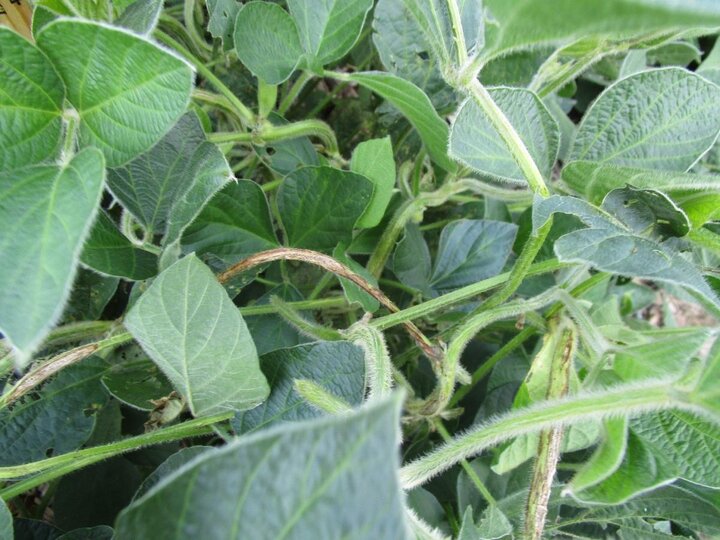Auxin type herbicides (eg. dicamba, 2,4-D) are an integral component of major cropping systems in North America. With the recent launching of Enlist E3 soybean in the U.S., in-season application of 2,4-D to soybean fields is expected to increase. This will enable use of Enlist One and Enlist Duo herbicides thus broadening farmers’ flexibility in controlling tough-to-control broadleaf and grass weeds including glyphosate-resistant biotypes. Despite the availability of new Enlist herbicides with low volatility potential, their potential off-target movement represents a major threat to non 2,4-D tolerant soybean as well as other broadleaf crops. Furthermore, the negative impact of 2,4-D drift on non-2,4-D tolerant crops may vary with the rate of the herbicide, crop type and/or growth stage at time of drift occurrence. Given its total acreage, this negative impact is likely to be more pronounced in the U.S. soybean belt. Of the approximately 240 million acres planted to the four major crops (i.e. corn, soybean, wheat and cotton) in the U.S. in 2018, corn and soybean accounted for 75% of the planted acreage and 90 million acres each (USDA Ag Outlook Forum for 2018 U.S. crop acreage, yield, production, and price projections for major U.S. crops). Although Enlist E3 soybean was available for planting in 2019 season, it will not be available in commercial quantities until the 2020 season. Since the majority of soybeans are still non-2,4-D tolerant soybean, it is important to understand the potential impact of 2,4-D drift. Therefore, field study was initiated in 2019 (and will be repeated in 2020) to measure the impact of 2,4-D micro-rates on four soybean types (Dicamba-Tolerant, Roundup Ready, Liberty-Link and Conventional soybean).
Study Procedure
Field trials were conducted in 2019 at Haskell Ag Lab, Concord, NE. The study was laid out in a randomized complete block design with eight replications and a split-split-plot arrangement. The main plot treatments consisted of three application times [second trifoliate (V2); beginning of flowering (V7/R1); and full flowering (R2)]; the sub plot treatments consisted of six micro rates of 2,4-D (1/5; 1/10; 1/50; 1/100; 1/500; and 1/1000 of the label recommended rate (32 oz/A) and a check with no herbicide applied; and the sub-sub plot treatments consisted of four soybean types (Dicamba-Tolerant, Roundup Ready, Liberty-Link, and Conventional). The first application time (V2) simulates early-season 2,4-D drift, and the remaining application times (V7/R1 and R2) simulate late-season 2,4-D drift when planting in neighboring fields is delayed. Several factors can lead to delay in planting (e.g. logistics, weather). To assess the impact of potential 2,4-D drift, visual injury ratings (VIR) on a scale of 0 (no injury) to 100 (complete injury) and plant height (PLHT; inches) measurements were collected at 7, 14 and 21 days after treatment (DAT). In addition, soybean yields were also collected. All data were analyzed in R-statistical software by regressing VIR, PLHT and soybean yield over 2,4-D micro rates.
Preliminary results
Much of the data is still being analyzed at the time of writing this article, thus the reader should consider data interpretations in this article as just preliminary conclusions.
Soybean Injury
Overall, soybean injuries increased with 2,4-D micro rates regardless of application time and soybean type. Similarly, highest injuries were observed when 2,4-D was applied at beginning of flowering (R1) versus second trifoliate (V2) and full flowering (R2) stages regardless of soybean type (Figure 1). On the other hand, the least injuries were observed at the R2 stage. Interestingly, 2,4-D applications at the V2 stage has consistently resulted in intermediate injury regardless of soybean type. This pattern, however, was observed both at 14 and 21 DAT (Figure 1). Furthermore, the injury due to 2,4-D was similar across all soybean types both at 14 and 21 DAT (Figure 1). In general, less than 1/10 of the label recommended dose of 2,4-D (3.2 oz A-1) was required to cause 5-20% injury to all soybean types at 14 and 21 DAT. All soybean types were more sensitive to 2,4-D either at R1 or R2 stage (Tables 1 and 2). This, therefore, suggests that soybean is more sensitive to potential 2,4-D drift at reproductive stages.
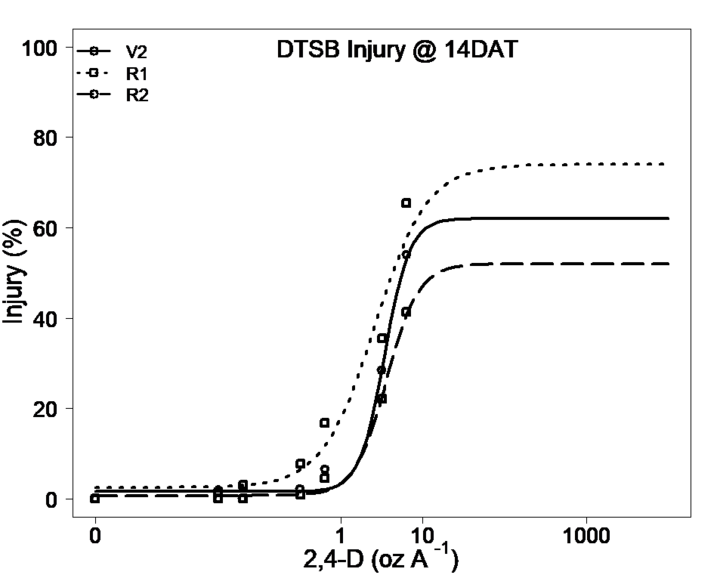
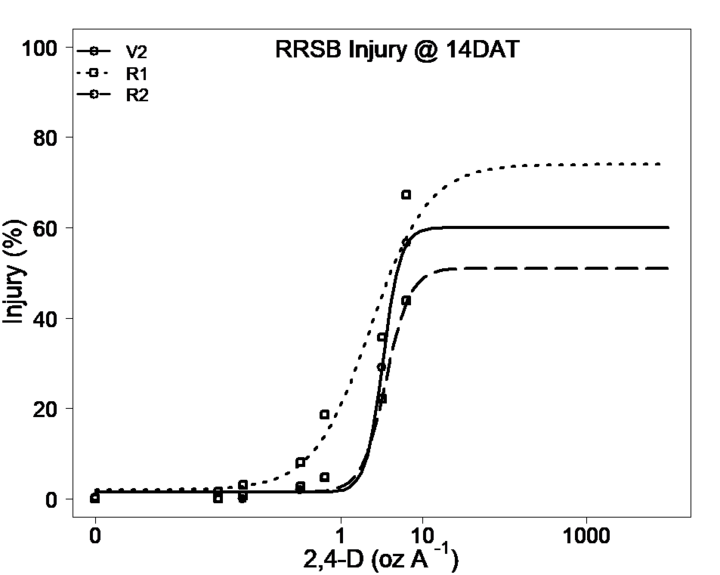
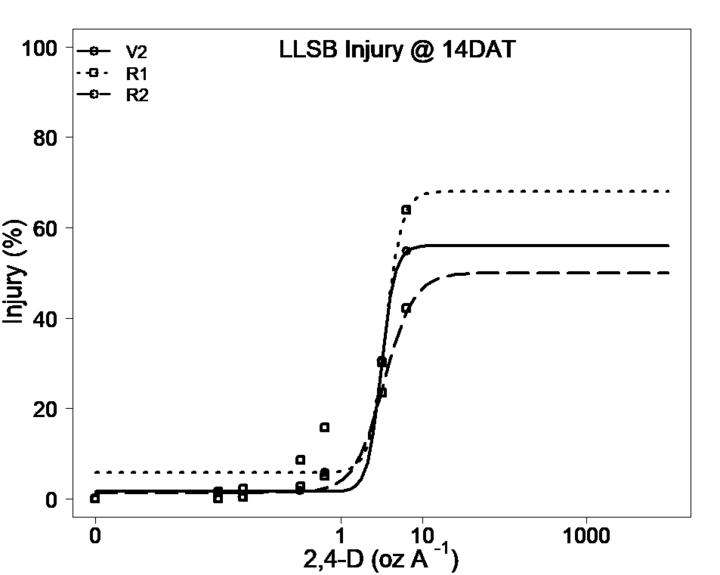
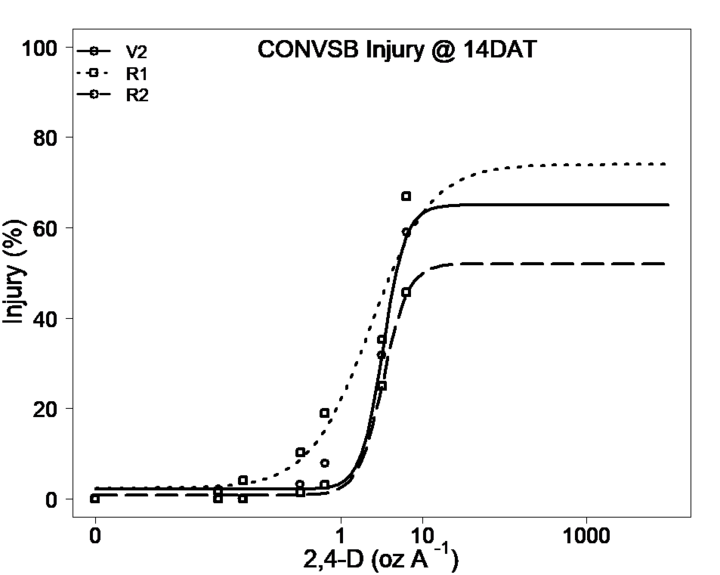

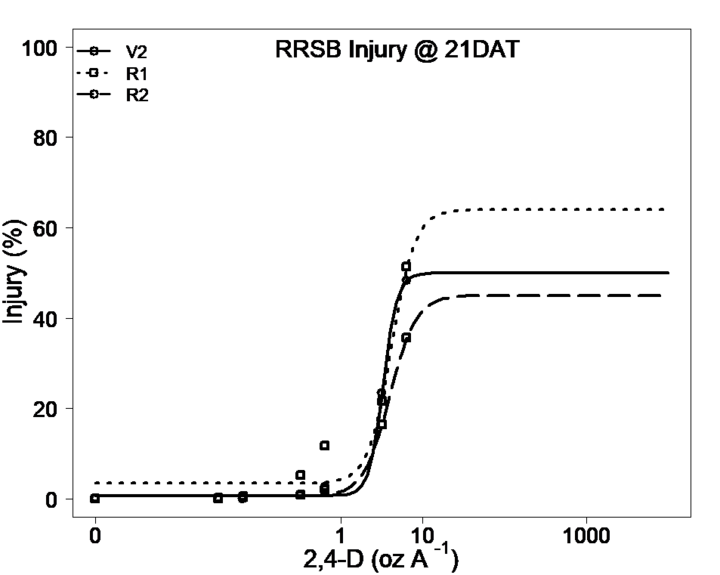
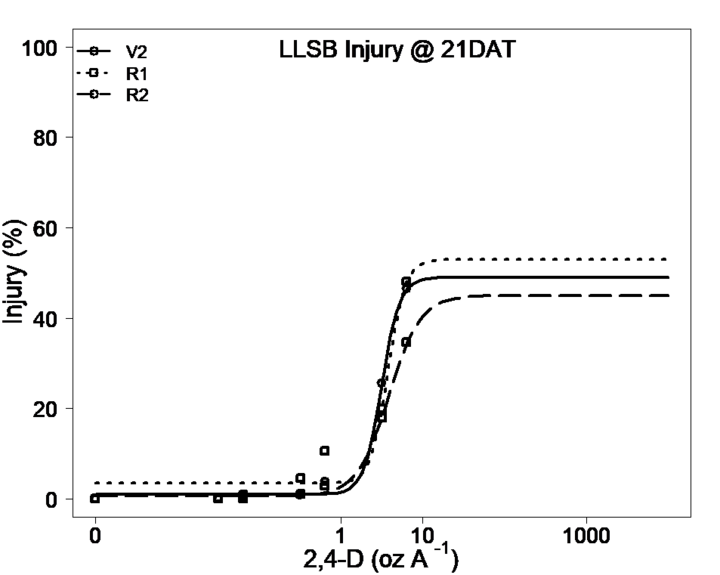

| Soybean type | App/stage | ED5 (SE) | ED10 (SE) | ED20 (SE) |
|---|---|---|---|---|
| ----------------------- 2,4-D in oz A-1 ----------------------- | ||||
| Dicamba-Tolerant | V2 | 1.21 (0.14) | 1.58 (0.14) | 2.10 (0.13) |
| V7/R1 | 0.29 (0.13) | 0.51 (0.18) | 0.93 (0.24) | |
| R2 | 0.97 (0.32) | 1.35 (0.35) | 1.95 (0.35) | |
| Roundup Ready | V2 | 1.60 (0.10) | 1.92 (0.09) | 2.34 (0.07) |
| V7/R1 | 0.21 (0.07) | 0.39 (0.11) | 0.76 (0.16) | |
| R2 | 1.31 (0.14) | 1.69 (0.14) | 2.22 (0.13) | |
| Liberty-Link | V2 | 1.77 (0.26) | 2.04 (0.23) | 2.39 (0.18) |
| V7/R1 | 1.80 (0.25) | 2.14 (0.22) | 2.57 (0.17) | |
| R2 | 0.97 (0.22) | 1.33 (0.23) | 1.87 (0.23) | |
| Conventional | V2 | 1.30 (0.17) | 1.65 (0.17) | 2.13 (0.15) |
| V7/R1 | 0.19 (0.07) | 0.35 (0.11) | 0.71 (0.17) | |
| R2 | 1.18 (0.13) | 1.53 (0.13) | 2.03 (0.13) | |
| Soybean type | App/stage | ED5 (SE) | ED10 (SE) | ED20 (SE) |
|---|---|---|---|---|
| ----------------------- 2,4-D in oz A-1 ----------------------- | ||||
| Dicamba-Tolerant | V2 | 1.47 (0.15) | 1.79 (0.14) | 2.22 (0.12) |
| V7/R1 | 2.81 (1.57) | 2.96 (1.06) | 3.12 (0.53) | |
| R2 | 1.09 (0.29) | 1.52 (0.31) | 2.18 (0.31) | |
| Roundup Ready | V2 | 1.84 (0.11) | 2.14 (0.10) | 2.51 (0.07) |
| V7/R1 | 1.58 (0.23) | 2.03 (0.22) | 2.65 (0.21) | |
| R2 | 1.34 (0.14) | 1.76 (0.14) | 2.38 (0.14) | |
| Liberty-Link | V2 | 1.50 (0.16) | 1.81 (0.15) | 2.22 (0.12) |
| V7/R1 | 1.86 (0.19) | 2.22 (0.18) | 2.70 (0.15) | |
| R2 | 1.04 (0.18) | 1.45 (0.19) | 2.07 (0.19) | |
| Conventional | V2 | 1.40 (0.15) | 1.74 (0.15) | 2.20 (0.13) |
| V7/R1 | 1.44 (0.28) | 1.86 (0.28) | 2.46 (0.26) | |
| R2 | 1.18 (0.13) | 1.57 (0.14) | 2.14 (0.14) | |
Soybean Height
Preliminary data analysis based on only 1 year of data showed that the impact of 2,4-D micro-rates on soybean height was clear with similar trends observed across all soybean types both at 14 and 21 DAT. In general, soybean height increased with application time. 2,4-D application at the trifoliate stage (V2) had greater impact on soybean height than the beginning of flowering (R1) and full flowering (R2) stages (Figure 2). The latter stage, R2, had the least impact on soybean height than other application timings. Despite the impact of 2,4-D on plant height, soybean continued to grow. For example, when 2,4-D was applied at V2, all soybean types grew 4-5 inches from 7 to 14 and 14 to 21DAT (data not shown). Conversely, at other application timings, R1 and R2 stages, all soybean types grew 1-3 inches more or less than the V2 application timing from 7 to 14 and 14 to 21DAT (data not shown). Less than 1/10 of the label recommended dose of 2,4-D (3.2 oz A-1) was required to reduce plant height by 5-20% across all soybean types and application timings both at 14 and 21 DAT (Tables 3 and 4). Interestingly, however, at 21 DAT, less than 1/100 of the label recommended dose of 2,4-D (0.32 oz A-1) caused 5% reduction in plant height in CONVSB but not in other soybean types (Table 4). With the exception of DTSB, at 21 DAT, ED value estimates (e.g. ED5, ED10 and ED20) tended to increase with application timings (Table 4) thus suggesting that soybean height is more sensitive to 2,4-D drift at early growth stages; however, the plants eventually outgrow the injury (Photo 1).
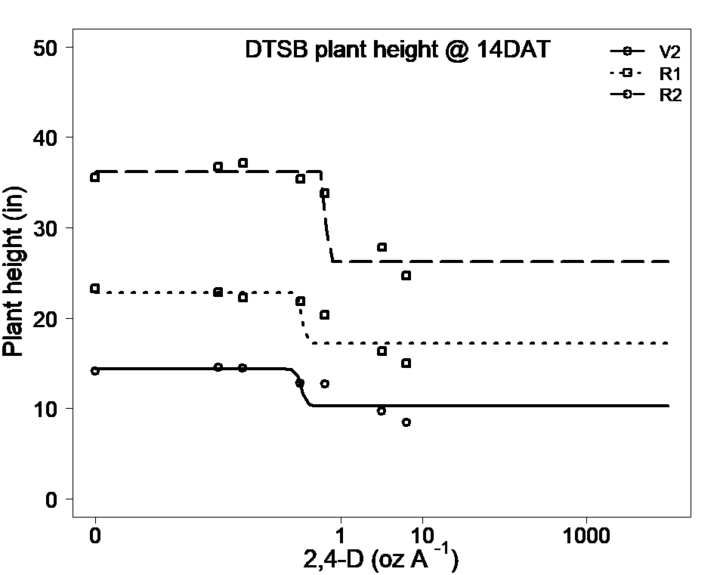
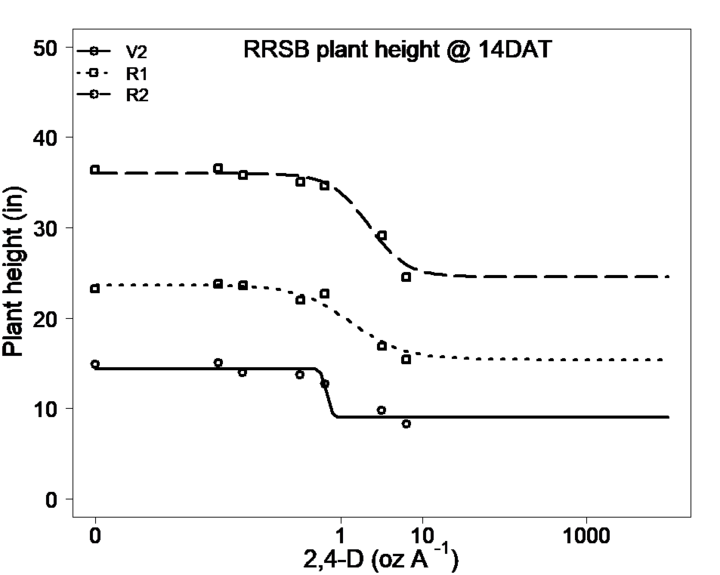
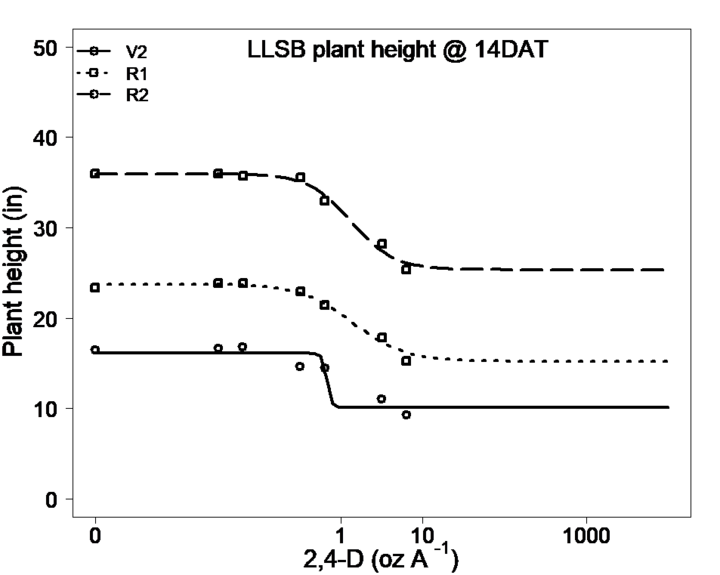
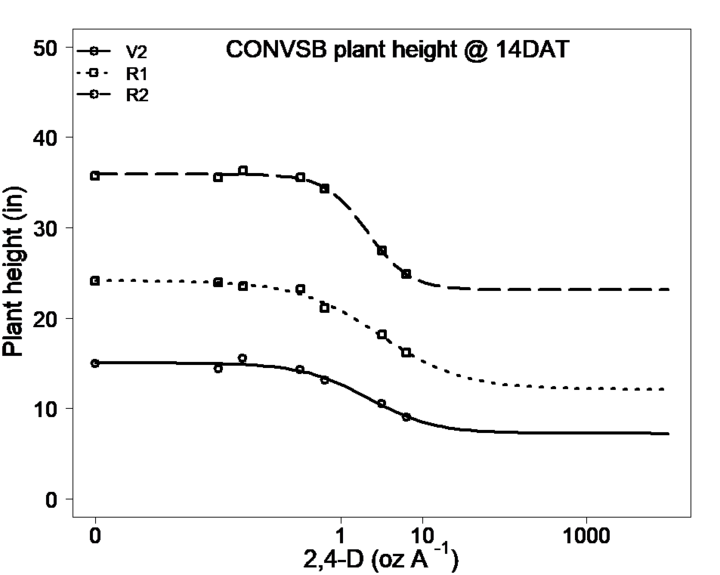
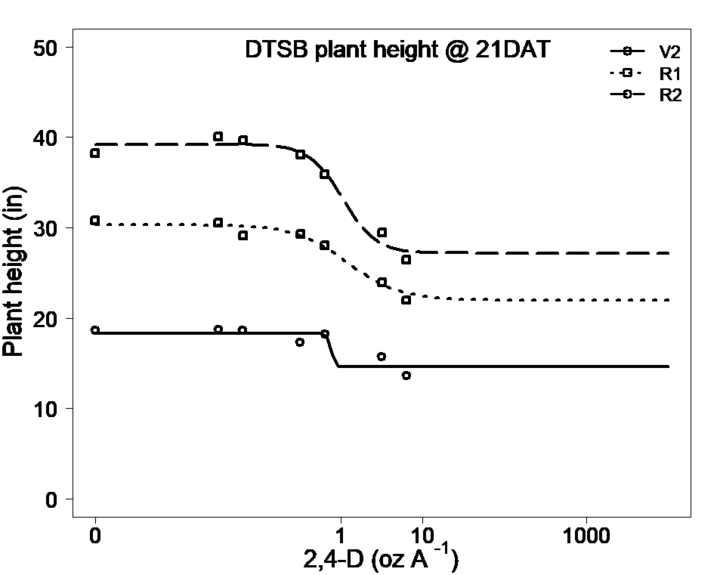
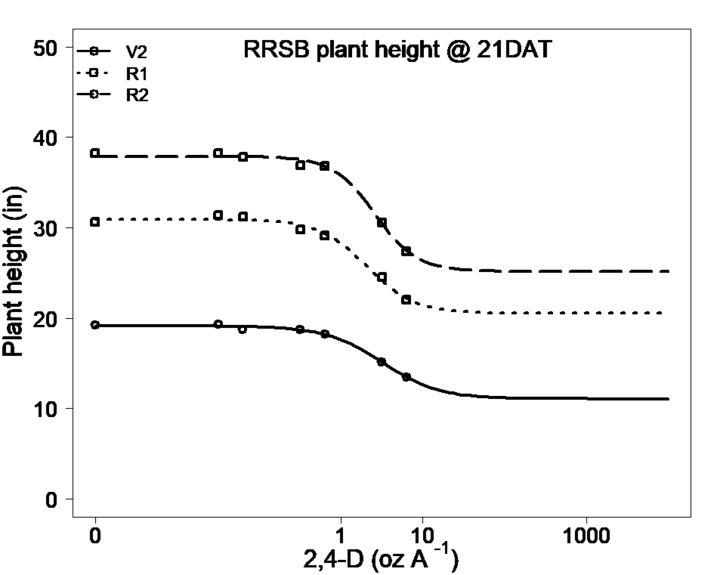

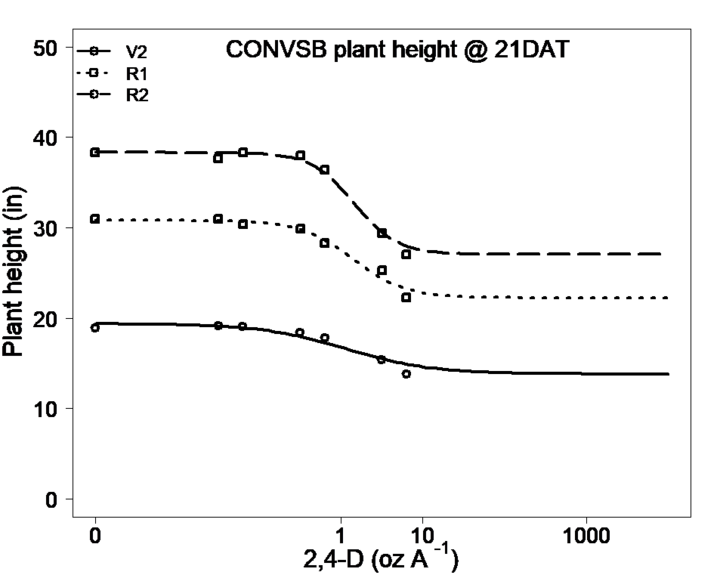
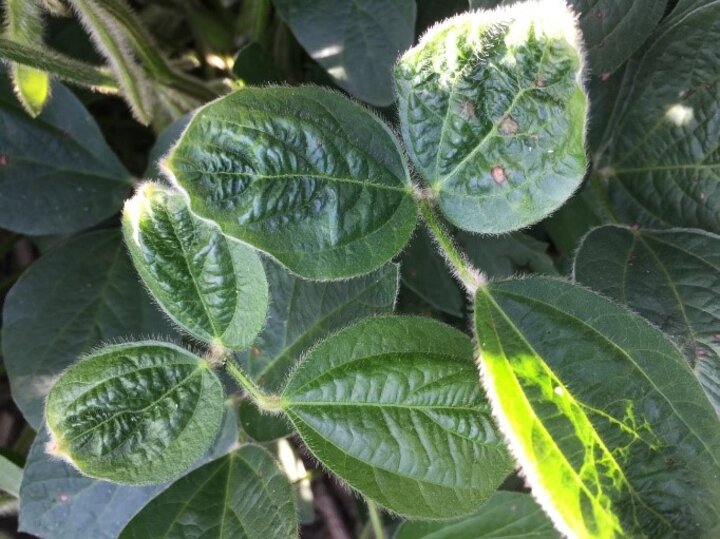
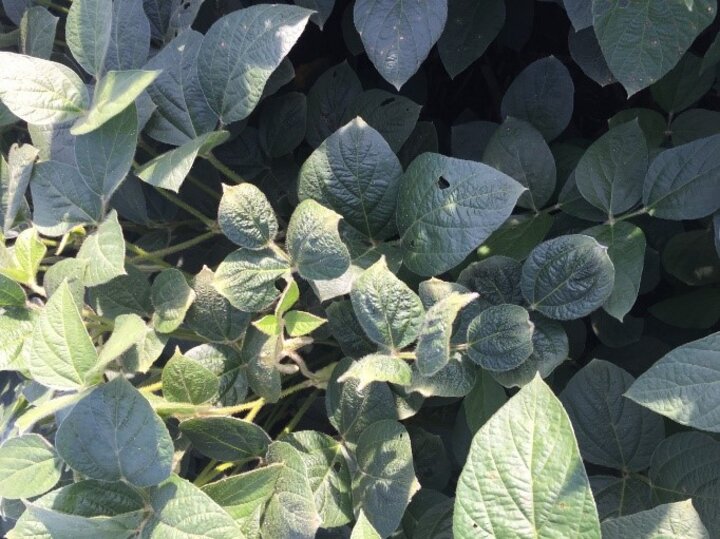
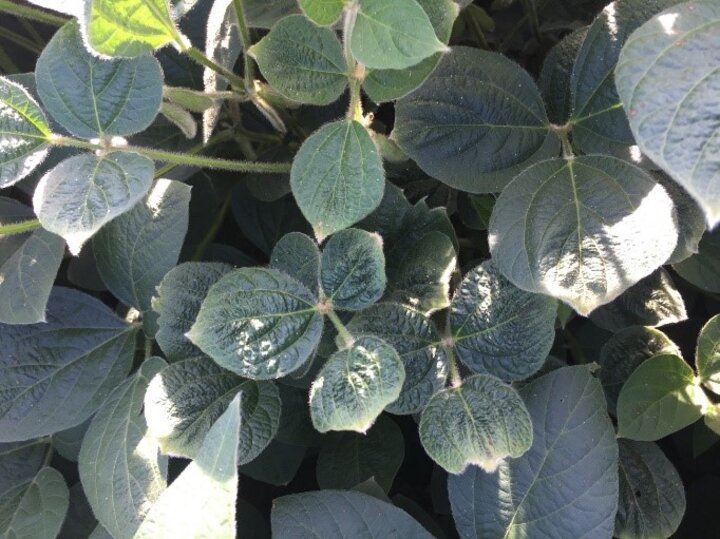
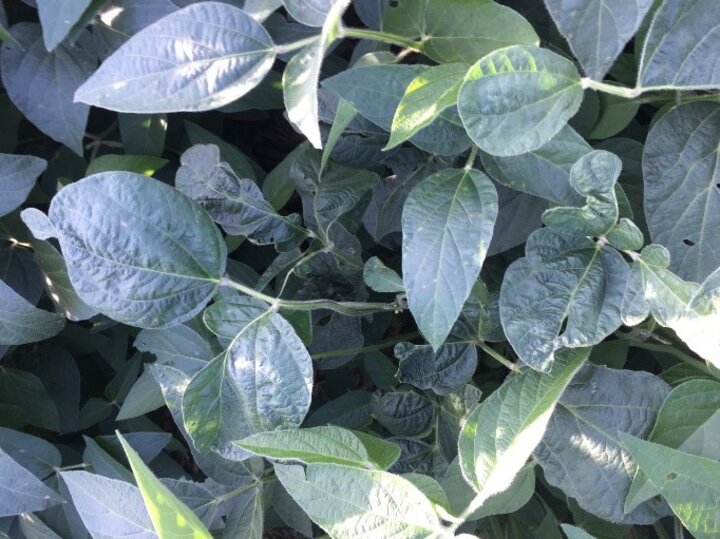
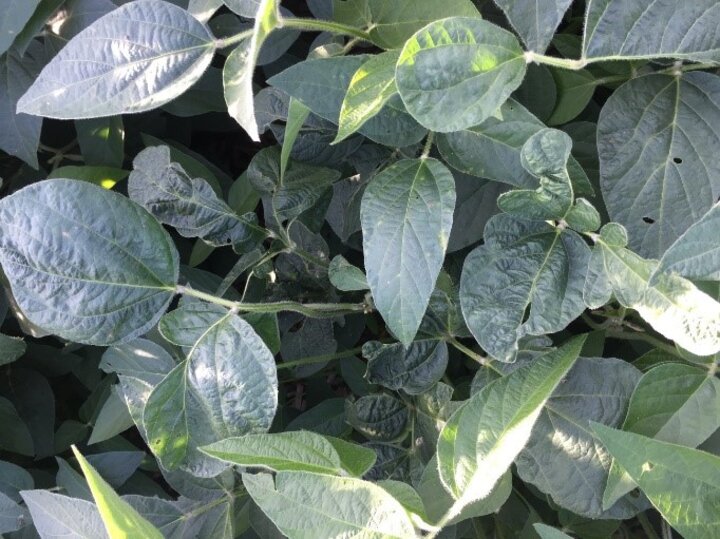
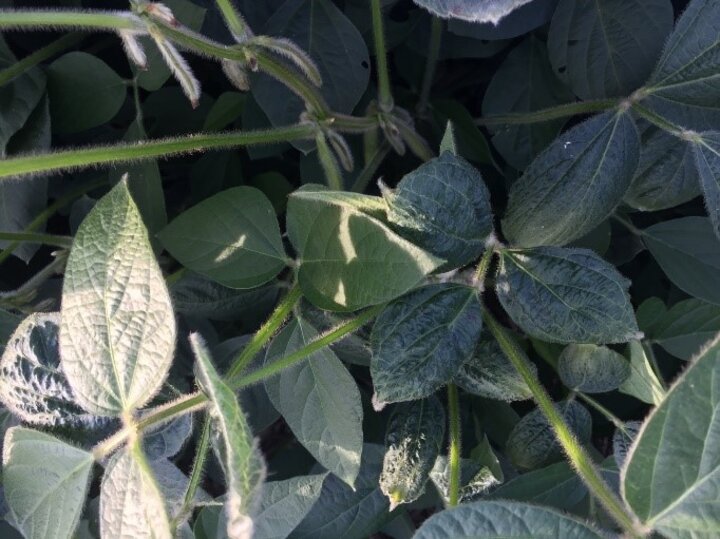
| Soybean type | App/stage | ED5 (SE) | ED10 (SE) | ED20 (SE) |
|---|---|---|---|---|
| ----------------------- 2,4-D in oz A-1 ----------------------- | ||||
| Dicamba-Tolerant | V2 | 0.26 (0.01) | 0.28 (0.01) | 0.29 (0.01) |
| V7/R1 | 0.30 (0.01) | 0.31 (0.01) | 0.32 (0.02) | |
| R2 | 0.60 (0.01) | 0.62 (0.01) | 0.64 (0.01) | |
| Roundup Ready | V2 | 0.55 (0.01) | 0.58 (0.01) | 0.61 (0.01) |
| V7/R1 | 0.14 (0.03) | 0.25 (0.06) | 0.46 (0.12) | |
| R2 | 0.45 (0.08) | 0.67 (0.12) | 1.04 (0.19) | |
| Liberty-Link | V2 | 0.56 (0.02) | 059 (0.02) | 0.62 (0.02) |
| V7/R1 | 0.15 (0.05) | 0.27 (0.09) | 0.49 (0.17) | |
| R2 | 0.23 (0.07) | 0.36 (0.11) | 0.58 (0.18) | |
| Conventional | V2 | 0.55 (0.02) | 0.57 (0.02) | 0.61 (0.02) |
| V7/R1 | 0.30 (0.02) | 0.31 (0.02) | 0.32 (0.02) | |
| R2 | 0.26 (0.08) | 0.41 (0.12) | 0.67 (0.20) | |
| Soybean type | App/stage | ED5 (SE) | ED10 (SE) | ED20 (SE) |
|---|---|---|---|---|
| ----------------------- 2,4-D in oz A-1 ----------------------- | ||||
| Dicamba-Tolerant | V2 | 0.65 (0.18) | 0.67 (0.19) | 0.70 (0.20) |
| V7/R1 | 0.13 (0.04) | 0.23 (0.08) | 0.43 (0.15) | |
| R2 | 0.32 (0.13) | 0.45 (0.18) | 0.67 (0.26) | |
| Roundup Ready | V2 | 0.30 (0.18) | 0.56 (0.27) | 1.07 (0.55) |
| V7/R1 | 0.28 (0.16) | 0.47 (0.26) | 0.81 (0.46) | |
| R2 | 0.45 (0.21) | 0.71 (0.33) | 1.15 (0.54) | |
| Liberty-Link | V2 | 0.56 (0.01) | 0.58 (0.01) | 0.60 (0.01) |
| V7/R1 | 0.59 (0.01) | 0.60 (0.01) | 0.62 (0.01) | |
| R2 | 0.60 (0.01) | 0.61 (0.01) | 0.62 (0.01) | |
| Conventional | V2 | 0.03 (0.01) | 0.08 (0.03) | 0.22 (0.09) |
| V7/R1 | 0.16 (0.04) | 0.28 (0.07) | 0.51 (0.13) | |
| R2 | 0.24 (0.08) | 0.39 (0.12) | 0.63 (0.21) | |
Soybean Yield
Preliminary data analysis based on only 1 year of data revealed that soybean yield was significantly impacted by 2,4-D micro-rates regardless of soybean type and application timing. It is worth noting, however, that differences between application timings were not clear especially in DTSB and LLSB (Figure 3). The trends in RRSB and CONCB, on the other hand, could be explained by the impact of 2,4-D on height (Figure 2). When left unsprayed in check plots, DTSB, RRSB, LLSB and CONVSB yielded approximately 67, 72, 66 and 68 bu/A, respectively. However, when the same soybeans were sprayed, for example, at the V2 stage with 1/10 of the label recommended dose of 2,4-D (3.2 oz/A), the yields were significantly reduced to 61, 57, 51 and 54 bu/A, respectively. Interestingly, when the same rate was applied at later stages, an even greater reduction in yield was observed. For example, when this same rate of 2,4-D was sprayed at the R1 stage, DTSB, RRSB, LLSB and CONVSB yielded 54, 55, 52 and 51 bu/A, respectively. When the highest dose of 2,4-D (6.4 oz/A) was sprayed at the V2, R1 and R2 stages, however, DTSB yielded 53, 52 and 50 bu/A, RRSB yielded 43, 51 and 53 bu/A, LLSB yielded 45, 45 and 53 bu/A, and CONVSB yielded 43, 44 and 44 bu/A, respectively. In general, with the exception of LLSB, consistently, less than 1/100 of the label recommended dose of 2,4-D (0.32 oz A-1) was required to reduce soybean yield at the R1 stage in all soybean types by 5%, (Table 5). It could be argued, therefore, that soybean seems to be more sensitive to potential 2,4-D drift at reproductive stages.
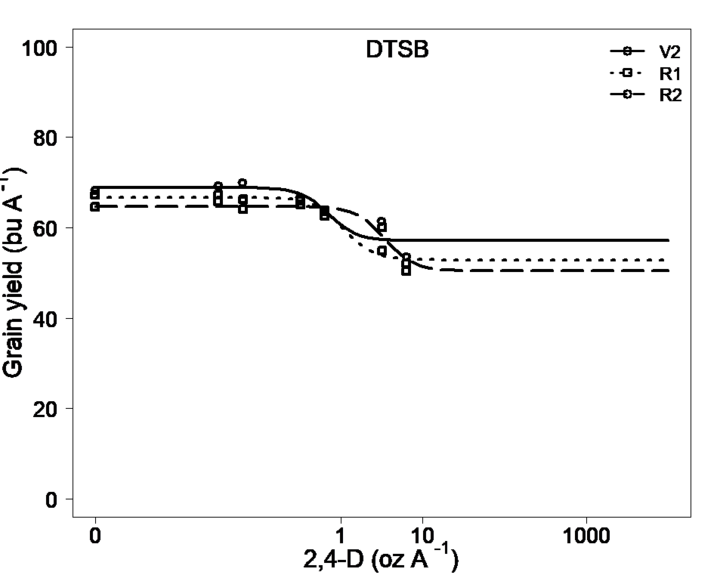

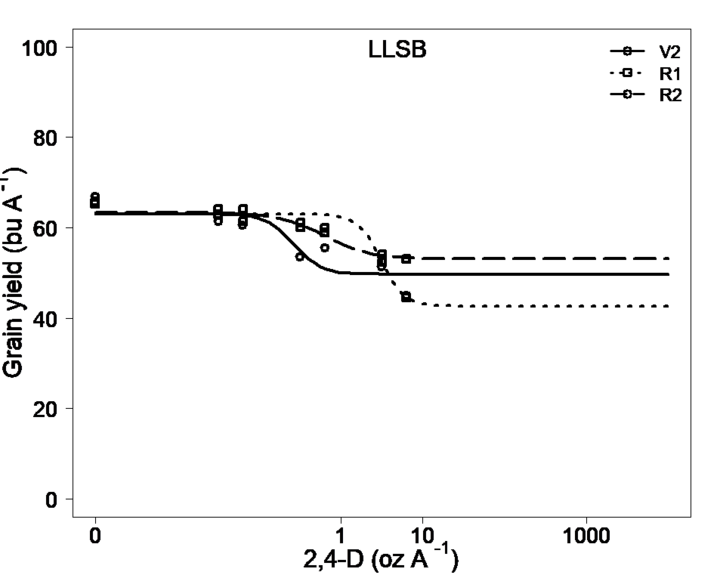
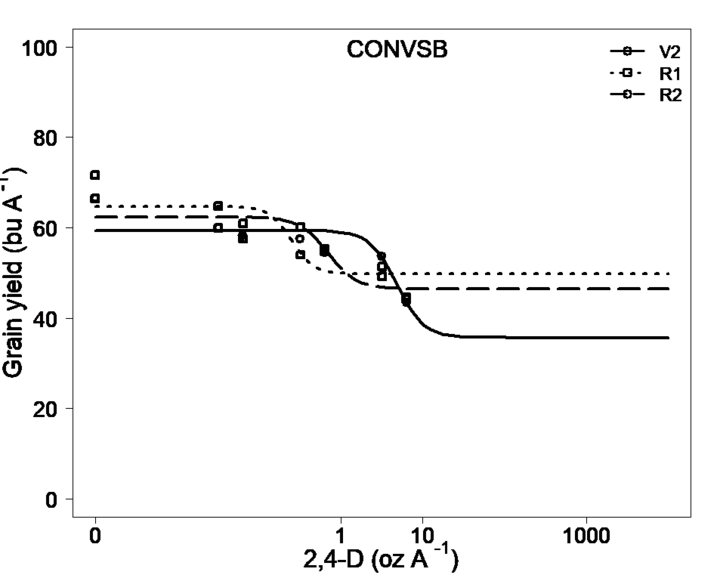
| Soybean type | App/stage | ED5 (SE) | ED10 (SE) | ED20 (SE) |
|---|---|---|---|---|
| ----------------------- 2,4-D in oz A-1 ----------------------- | ||||
| Dicamba-Tolerant | V2 | 0.21 (0.11) | 0.29 (0.15) | 0.41 (0.21) |
| V7/R1 | 0.31 (0.16) | 0.43 (0.22) | 0.61 (0.31) | |
| R2 | 1.02 (0.27) | 1.39 (0.37) | 1.95 (0.52) | |
| Roundup Ready | V2 | 2.45 (1.23) | 2.67 (0.91) | 2.93 (0.49) |
| V7/R1 | 0.004 (0.002) | 0.01 (0.00) | 0.02 (0.00) | |
| R2 | 0.02 (0.00) | 0.01 (0.01) | 0.04 (0.01) | |
| Liberty-Link | V2 | 0.08 (0.03) | 0.11 (0.04) | 0.15 (0.05) |
| V7/R1 | 1.18 (0.19) | 1.51 (0.25) | 1.97 (0.32) | |
| R2 | 0.09 (0.03) | 0.15 (0.05) | 0.25 (0.09) | |
| Conventional | V2 | 1.57 (0.63) | 2.09 (0.84) | 2.85 (1.14) |
| V7/R1 | 0.09 (0.03) | 0.12 (0.04) | 0.16 (0.06) | |
| R2 | 0.21 (0.04) | 0.28 (0.05) | 0.40 (0.07) | |
Soybean Yield Loss
In general, preliminary data analysis based on only 1 year of data showed that yield losses increased with dose of 2,4-D regardless of soybean type (Figure 4). Yield losses ranged from 0 to 21, 3.7 to 35, 8 to 32.7 and 9.7 to 34.8% when the dose of 2,4-D sprayed at the V2 stage on DTSB, RRSB, LLSB and CONVSB, respectively, was increased from 0.032 to 6.4 oz/A. When DTSB, RRSB, LLSB and CONVSB were sprayed at the R1 stage with 2,4-D dose ranging from 0.032 to 6.4 oz/A, yield losses increased from 0 to 22, 6.5 to 29.7, 2.4 to 32 and 9.3 to 37.7%, respectively. The risk of yield loss was equal or relatively lower when 2,4-D was applied at the R2 stage regardless of soybean type. Increasing the dose of 2,4-D sprayed at the R2 stage on DTSB, RRSB, LLSB and CONVSB from 0.032 to 6.4 oz/A increased yield losses from 0 to 23, 6 to 29, 3.6 to 18.7 and 9.6 to 33.4%, respectively. Less than 1/10 of the label recommended dose of 2,4-D (0.64 oz/A) was required to cause 5-20% yield loss regardless of soybean type (Table 6). Based on the ED value estimates, the reproductive stages required the least amount of 2,4-D to cause yield loss except in LLSB. For example, only 0.01 oz/A of 2,4-D was required to cause 5% yield loss when sprayed at the R1 stage on either RRSB and CONVSB (Table 6). This suggests that soybean seems to be more sensitive to yield loss due to potential 2,4-D drift at the reproductive stages.
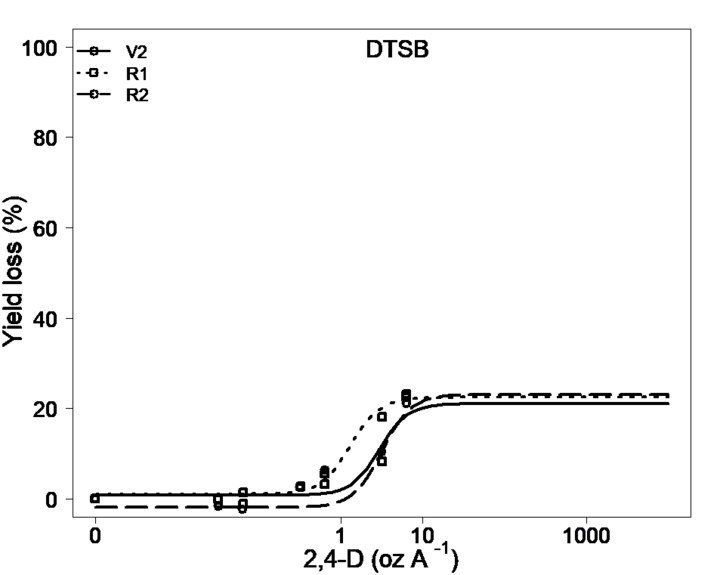
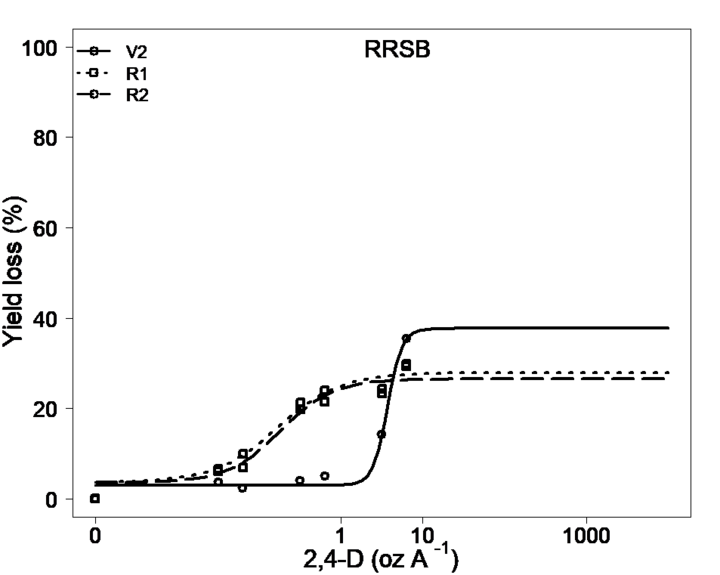

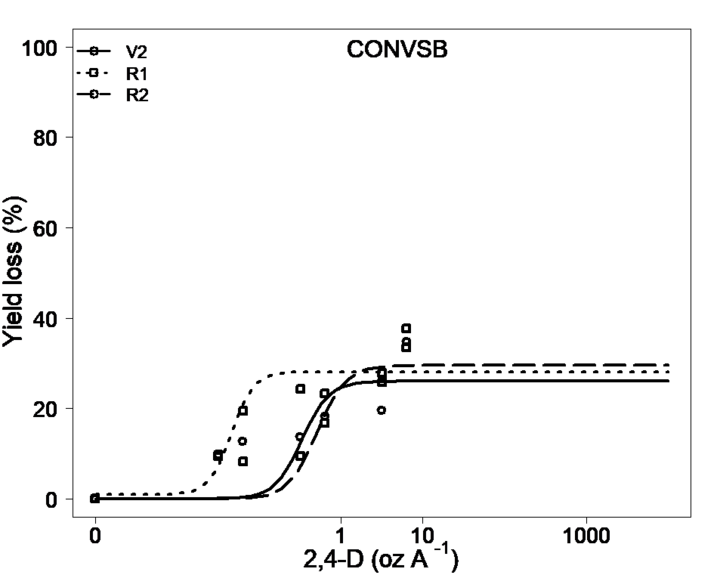
| Soybean type | App/stage | ED5 (SE) | ED10 (SE) | ED20 (SE) |
|---|---|---|---|---|
| --------------------------- 2,4-D in oz A-1 --------------------------- | ||||
| Dicamba-Tolerant | V2 | 0.90 (0.18) | 1.22 (0.25) | 1.69 (0.35) |
| V7/R1 | 0.37 (0.19) | 0.51 (0.26) | 0.72 (0.37) | |
| R2 | 0.94 (0.27) | 1.28 (0.37) | 1.79 (0.52) | |
| Roundup Ready | V2 | 2.03 (0.17) | 2.37 (0.19) | 2.80 (0.23) |
| V7/R1 | 0.01 (0.00) | 0.02 (0.01) | 0.04 (0.06) | |
| R2 | 0.02 (0.01) | 0.03 (0.01) | 0.06 (0.02) | |
| Liberty-Link | V2 | 0.02 (0.00) | 0.03 (0.01) | 0.04 (0.01) |
| V7/R1 | 1.07 (0.21) | 1.37 (0.27) | 1.78 (0.35) | |
| R2 | 0.05 (0.02) | 0.09 (0.03) | 0.16 (0.06) | |
| Conventional | V2 | 0.10 (0.03) | 0.14 (0.04) | 0.19 (0.06) |
| V7/R1 | 0.01 (0.00) | 0.02 (0.00) | 0.03 (0.01) | |
| R2 | 0.15 (0.02) | 0.21 (0.04) | 0.29 (0.05) | |
Summary, Conclusions and Implications
Results from this study clearly show that all non-2,4-D tolerant soybean types (DTSB, RRSB, LLSB and CONVSB) were sensitive to micro-rates of 2,4-D as evident by an increase in visual injury and a reduction in both plant height and grain yield with an increase in the dose of 2,4-D sprayed regardless of application time. All of the above also clearly delayed canopy closure especially when earlier application timings were targeted (data not shown). This delay in canopy closure and reduction in plant height were a result, in part, of a more stunted (Photo 2) and epinastic growth (Photo3) following 2,4-D application especially in younger plants. Potential implications of this includes reduced crop competitiveness against weeds. It is also worth noting, however, that flowering and maturity were delayed (data not shown) which could potentially pushback harvesting as well as planting of subsequent crops in double crop soybean systems. Delaying harvesting, on the other hand, could subject soybean to early frost damage.
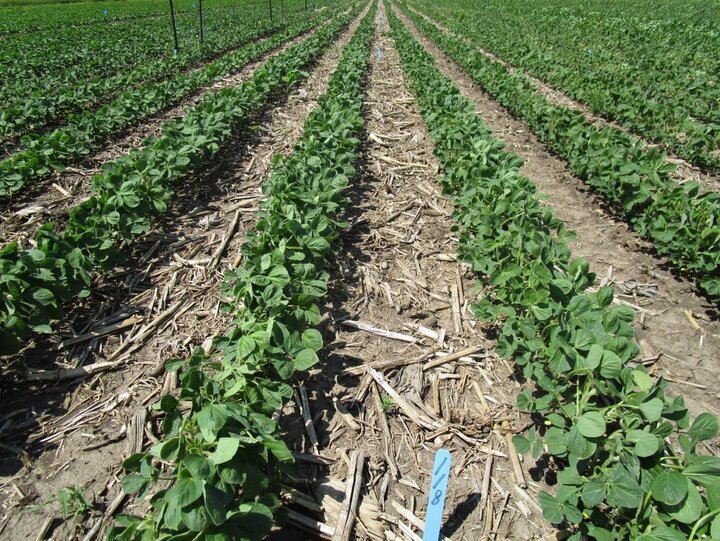
This study also shows that the impact of 2,4-D micro-rates on non-2,4-D tolerant soybean largely depend on application time with later growth stages being the most sensitive as we observed in a previous study where we looked at the impact of dicamba micro-rates on non-dicamba soybeans. For example, when XtendiMax was sprayed at 1/10 of the label recommended dose (2.2 oz A-1) at V2, CONVSB, LLSB and RRSB yield decreased from 58 to 25, 61 to 27, and 63 to 33 bu/A, respectively, compared with non-sprayed control plots. The same 1/10 rate of XtendiMax when sprayed at the R1 stage, however, further decreased CONVSB, LLSB and RRSB yield to 3, 2 and 5 bu/A, respectively. Therefore, like dicamba, it is important to prevent potential 2,4-D drift onto non-2,4-D tolerant soybean especially late in the season.
